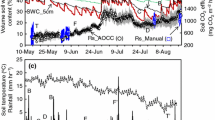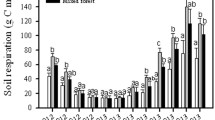Abstract
The parameter Q10 is commonly used to express the relationship between soil CO2 efflux and soil temperature. One advantage of this parameter is its application in a model expression of respiration losses of different ecosystems. Correct specification of Q10 in these models is indispensable. Soil surface CO2 efflux and soil temperature at different depths were measured in a 21-year-old Norway spruce stand and a mountain grassland site located at the Experimental Ecological Study Site Bily Kriz, Beskydy Mts. (NE Czech Republic), using automated gasometric systems. A time-delay and goodness-of-fit between soil CO2 efflux and soil temperature at different measuring depths were determined. Wide ranges of values for the time-delay of CO2 efflux in response to temperature, Q10 and the determination coefficient (R2) between CO2 efflux and temperature were obtained at the both sites. The values of Q10 and the CO2 time-delay increased with depth, while the R2 of the CO2-temperature relationship significantly decreased. Soil temperature records obtained close to the soil surface showed the highest values of R2 and the lowest value of the time-delay at both sites. Measurement of soil temperature at very shallow soil layer, preferably at the soil surface, is highly recommended to determine useable values of Q10. We present a new procedure to normalize Q10 values for soil temperatures measured at different depths that would facilitate comparison of different sites.





Similar content being viewed by others
References
Akinremi OO, McGinn SM, McLean HDJ (1999) Effects of soil temperature and moisture on soil respiration in barley and fallow plots. Can J Soil Sci 79:5–13
Amthor JS (1994) Plant respiratory responses to the environmental and their effects on the carbon balance. In: Wilkinson RE (ed) Plant-Environment interactions. Marcel Dekker Inc., New York, pp501–554
Boone RD, Nadelhoffer KJ, Canary JD, Kaye JP (1998) Roots exert a strong influence on the temperature sensitivity of soil respiration. Nature 396:570–572
Buchmann N (2000) Biotic and abiotic factors controlling soil respiration rates in Picea abies stands. Soil Biol Biochem 32:1625–1635
Brumme R (1995) Mechanisms of carbon and nutrient release and retention in beech forest gaps: III environmetal regulation of soil respiration and nitrous oxide emissions along a microclimatic gradient. Plant Soil 168–169:593–600
Chen H, Tian HQ (2005) Doues a general temperature-dependent Q10 model of soil respiration exist at biome and global scale? J Integr Plant Biol 47(11):1288–1302
Davidson E, Belk E, Boone R (1998) Soil water content and temperature as independent or confounded factors controlling soil respiration in a temperate mixed hardwood forest. Glob Change Biol 4(2):217–227
Davidson E, Jansens I, Luo Y (2006) On the variability of respiration in terrestrial ecosystems: moving beyond Q10. Glob Change Biol 12(2):154–164
Epron D, Farque L, Lucot É, Badot P (1999) Soil CO2 efflux in a beech forest:dependence on soil temperature and soil water content. Ann For Sci 56:221–226
Fang C, Moncrieff JB, Gholz HL, Clark KL (1998) Soil CO2 efflux and its spatial variation in a florida slash pine plantation. Plant Soil 205:135–146
Fang C, Moncrieff JB (2001) The dependence of soil CO2 efflux on temperature. Soil Biol Biochem 33:155–165
Fang C, Smith P, Moncrieff JB, Smith JU (2005) Similar response of labile and resistant soil organic matter pools to change in temperature. Nature 436(7052):881–881
Guangmin C, Yanhong T, Wenhong M, Yuesi W, Yingnian L, Xingquan Z (2004) Grazing intensity alters soil respiration in an alpine meadow on the Tibetan plateau. Soil Biol Biochem 36:237–243
Hanson PJ, Edwards NT, Garten CT, Andrews JA (2000) Separating root and soil microbial contributions to soil respiration: a review of methods and observations. Biogeochemistry 48:115–146
Hashimoto S (2005) Q(10) values of soil respiration in Japanese forests. J For Res 10(5):409–413
Hirano T, Honghyun K, Tanaka Y (2003) Long-term half-hourly measurement of soil CO2 concentration and soil respiration in a temperature deciduous forest. J Geophys Res 108(D20):4631
Janssens IA, Meiresonne L, Ceulemans R (1999) Mean soil CO2 efflux from a mixed forest: temporal and spatial integration. In: Ceulemans R, Veroustraete F, Gond V, Rensbergen J (eds) Forest ecosystem modelling, upscaling and remote sensing. SPB Academic Publishing, The Hague, pp 19–33
Knorr W, Prentice IC, House JI, Holland EA (2005) Long-term sensitivity of soil carbon turnover to warming. Nature 433(7023):298–301
Lavigne MB, Franklin SE, Hunt Jr ER (1996) Estimating stem maintenance respiration rates of dissimilar balsam fir stands. Tree Physiol 16:687–695
Linder S, Troeng E (1981) The seasonal variation in stem and coarse root respiration of a 20-year-old Scots pine (Pinus sylvestris L.). In: W. Tranquillini (ed) Dickenwachstum der Bäume, Mitt. Forstl., vol 142. Bundesversuchsanst Wien, pp125–140
Lloyd J, Taylor JA (1994) On the temperature dependence of soil respiration. Funct Ecol 8:315–323
Pajari B (1995) Soil respiration in poor upland site of Scots pine stand subjected to elevated temperatures and atmospheric carbon concentration. Plant Soil 168–169:563–570
Pavelka M, Acosta M, Janouš D (2004) A new device for continuous CO2 flux measurments in forest stand. Ecology 23(2):88–100
Penning de Vries FWT (1975) The cost of maintenance processes in plant cells. Ann Bot 39:77–92
Ryan MG, Linder S, Vose JM, Hubbard RM (1994) Dark respiration of pines (Copenhagen). Ecol Bull 43:50–63
Ryan MG, Gower ST, Hubbard RM, Waring RH, Gholz HL, Cropper WP, Running SM (1995) Woody tissue maintenance respiration of four conifers in contrasting climates. Oecologia 101:133–140
Raich JW, Schlesinger WH (1992) The global carbon dioxide flux in soil respiration and its relationship to vegetation and climate. Tellus 44B:81–99
Reichstein M, Subke JA, Angeli AC, Tenhunen JD (2005) Does the temperature sensitivity of descomposition of soil organic matter depen upon water content, soil horizon, or incubation time? Glob Change Biol 11(10):1754–1767
Rayment MB, Jarvis PG (1997) An improving open chamber system for measuring soil CO2 efflux in the field. J Geophys Res-Atmos 102(D24):28779–28784
Rey A, Pegoraro E, Tedeschi V, De Parri I, Jarvis PG, Valentini R (2002) Annual variation in soil respiration and its components in a coppice oak forest in Central Italy. Glob Change Biol 8(9):851–866
Singh JS, Gupta SR (1977) Plant decomposition and soil respiration and soil respiration in terrestrial ecosystems. Bot Rev 43:449–528
Soe ARB, Buchmann N (2005) Spatial and temporal variations in soil respiration in relation to stand structure and soil parameters in an unmanaged beach forest. Tree Physiol 25:1427–1436
Stockfors J (2000) Temperature variation and distribution of living cells within tree stems: implications for stem respiration modelling and scale up. Tree Physiol 20:1057–1062
Tjoelker MG, Oleksyn J, Reich PB (2001) Modelling respiration of vegetation: evidence for a general temperature-dependent Q10. Glob Change Biol 7(2):223–230
Acknowledgments
This work was supported by grants GACR 526/03/H036, MSMT CR VaV/640/18/03, EU GOCE-CT-2003-505572 and the research intention AV0Z60870520 (Academy of Sciences of the Czech Republic). Marian Pavelka and Manual Acosta were also supported by the programme ‘The Role of Soils in the Terrestrial Carbon Balance’ by the European Science Foundation.
Author information
Authors and Affiliations
Corresponding author
Rights and permissions
About this article
Cite this article
Pavelka, M., Acosta, M., Marek, M.V. et al. Dependence of the Q10 values on the depth of the soil temperature measuring point. Plant Soil 292, 171–179 (2007). https://doi.org/10.1007/s11104-007-9213-9
Received:
Accepted:
Published:
Issue Date:
DOI: https://doi.org/10.1007/s11104-007-9213-9




